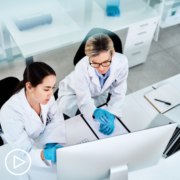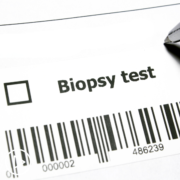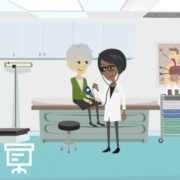AML Diagnosis | Exploring Bone Marrow Biopsy and Alternatives
AML Diagnosis | Exploring Bone Marrow Biopsy and Alternatives from Patient Empowerment Network on Vimeo.
What are the purpose and alternatives to bone marrow biopsy? Expert Dr. Sara Taveras Alam from UTHealth Houston explains what’s involved in bone marrow biopsy, what is analyzed, patient advice for the procedure, and alternative testing methods.
[ACT]IVATION Tip
“…ask the providers what to expect from the bone marrow in the facility where you are in. Usually in all facilities, lidocaine, or local anesthesia is used, but if you foresee that in general, you are anxious about procedures or susceptible to pain, you are welcome to request for some medications for pain and anxiety to help you get through that procedure, and generally, once patients have undergone a first bone marrow biopsy, they know what to expect and what accommodations may be needed for them in subsequent bone marrow biopsies.”
Related Resources:

Advancements in AML Treatment | Tailoring Therapies to Individual Patients |

|

|
Transcript:
Lisa Hatfield:
Dr. Taveras, what specific features are pathologists looking for in the bone marrow sample when diagnosing AML, and are there any alternative diagnostic methods or tests available for AML besides a bone marrow biopsy?
Dr. Sara Taveras Alam:
And that is a great question. I think that many patients may be scared of what bone marrow biopsy entails. It is a procedure after all, and it can be painful. I do know that they’re able to get some details about the diagnosis from the peripheral blood just from blood tests alone; however, the best diagnosis is performed through the bone marrow biopsy, so it can provide more information about the email, than what we’re able to obtain from the blood, sometimes the blood count, the white blood cell counts are elevated in AML and that may make it easy to do some of our testing from the blood work, but in other patients, the white blood cells may be low at presentation and that can make it very difficult to obtain any meaningful diagnostic and prognostic information without a bone marrow biopsy.
The bone marrow biopsy would also allow to tell if the patient had a preceding blood disorder like a myeloid dysplasia and this may have treatment implications. This is not something that we would be able to tell from the blood alone unfortunately, so when our pathologists look at the bone marrow sample, they are looking at some of the blood that is obtained from that boom marrow space where the blood is produced, and a tiny piece of the bone from there as well, and they’re looking at the amount of cells, especially the normal red cells, the normal white blood cells, normal platelets, and specifically the abnormal white blood cells or blasts that are quantified in a percentage fashion to diagnose the AML.
There are also different types of blasts, so they may be able to sub-classify the AML from just looking at the morphology or how these cells look under the microscope. There are many ancillary tests that are performed on the sample as well to look into the genetics for the driving forces behind the acute myeloid leukemia.
We look at a chromosome analysis to see what the chromosomes are for the leukemia. We look at mutations during FISH testing, and we do molecular testing that are looking at specific point mutations that may be associated with AML and provide insight into the treatment options as well as the prognosis, the patient’s disease, and whether or not they may benefit from a stem cell transplant to increase the chances of maintaining a remission and obtaining a cure.
My advice for patients who may be anxious about the bone marrow biopsy would be to voice their concerns for their providers. I believe that different centers have different practices as it relates to pre-medication, so some places may provide anxiety medications and pain medications in advance of the procedure, but some other facilities may not. So my activation tip for this question is to ask the providers what to expect from the bone marrow in the facility where you are in.
Usually in all facilities, lidocaine, or local anesthesia is used, but if you foresee that in general, you are anxious about procedures or susceptible to pain, you are welcome to request for some medications for pain and anxiety to help you get through that procedure, and generally, once patients have undergone a first bone marrow biopsy, they know what to expect and what accommodations may be needed for them in subsequent bone marrow biopsies.










